Fruit Tree Diseases: The Most Important
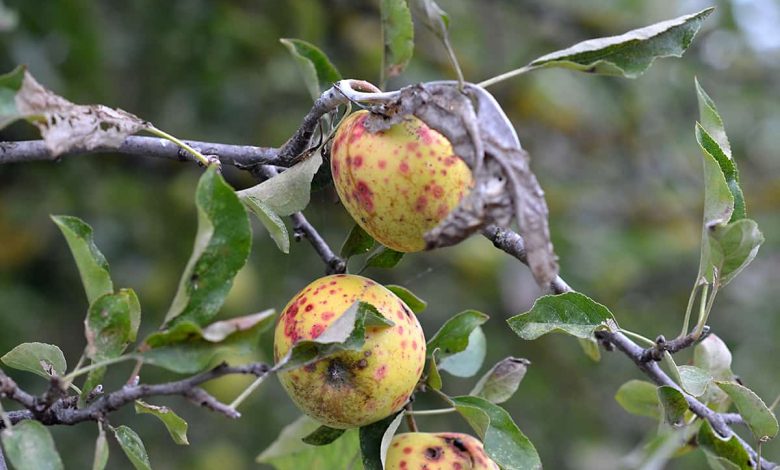
Hi Farmers. In this article we are going to talk about the main diseases that affect fruit trees. We will also explain what their symptoms are so that you know how to identify them and thus be able to apply a correct treatment and adopt the most appropriate preventive measures.
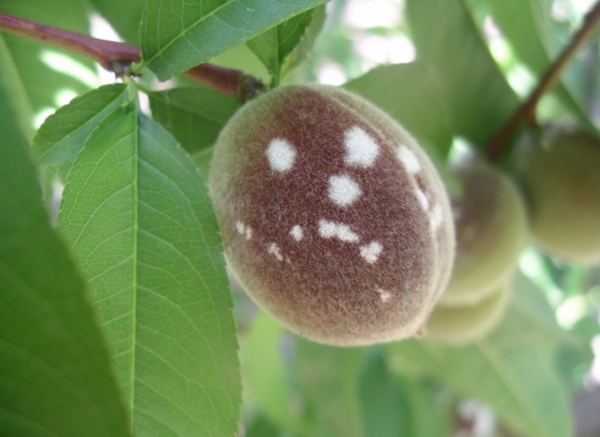
1. Root and neck galls or tumors (Agrobacterium spp.)
This disease is caused by bacteria of the Agrobacterium genus, which are capable of infecting numerous crops and forest species. These bacteria can survive in the soil in the absence of a host by feeding on decaying organic debris. They adapt to various types of soil although they prefer those with a basic pH
1.1. Damage and symptoms caused by Agrobacterium
They enter the plant through wounds caused by pruning elements, frost, insects, etc., and cause the tree to produce a large number of hormones that give rise to the development of galls such as those that can be seen in the image.
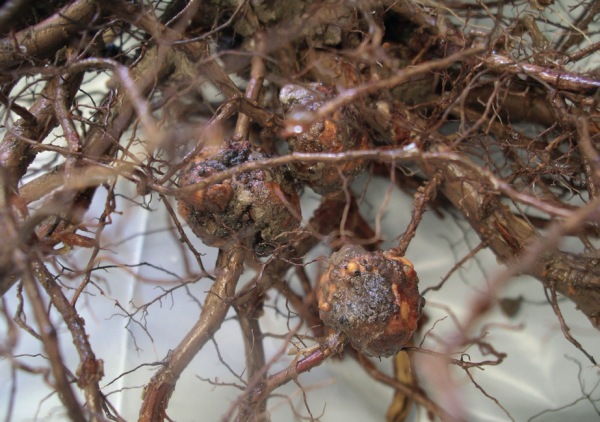
At the beginning of the infection, these galls or tumors will be smaller in size, soft in consistency, appearing in areas of the tree close to the ground, such as the base of the trunk or the roots, although in some cases they may also appear on the branches. Over time, these bumps will get bigger and bigger, hindering the circulation of the sap and may even cause the death of the tree.
1.2. Control and prevention measures for Agrobacterium
Currently, no chemical or biological control measure is known to eradicate the disease, so all operations will be aimed at prevention:
- Remove infected plants
- Thoroughly clean and disinfect pruning instruments
- Avoid activities that can cause injury
- Incorporating potassium into the soil with a moderate dose of nitrogen hinders the appearance of cracks due to frost, therefore, in turn, we would be reducing the potential entry of the pathogen into the tree.
2. Root and neck rot (Phytophthora spp)
Root and collar rot, also known as collar disease, is a disease caused by fungi of the genus Phytophthora spp. Most fruit trees, if not all, are susceptible to it. These pathogens live in the soil and will cause damage to the roots of the tree.
Its proliferation is favored by waterlogging and excessive humidity, so irrigation will increase the probability of suffering from the disease.
2.1. Damage and symptoms caused by Phytophthora
The most general symptom will be the decay of the tree, easily confused with those produced by other diseases such as Rosellinia or Armillaria. To distinguish them, we must lift a piece of the bark from the base of the trunk. If it is Phytophthora, this area should present a black spot due to the death of the internal tissues, similar to the one in the following image:
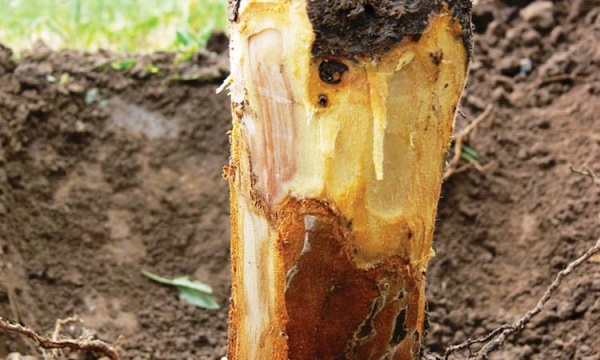
2.2. Phytophthora control and prevention measures
To date, there are no chemical or biological control measures that are 100% effective in the fight against fungi of the Phytophthora genus. Therefore, most strategies will aim at prevention:
- Incorporate drainage systems that prevent waterlogging
- In the case of using irrigation, let it be by dripping, installing the emitters as far away as possible from the base of the trunk and establishing short and frequent durations.
- Use resistant patterns
- Remove infected trees.
- Moderate nitrogen fertilization
- In the case of incorporating organic matter, its placement in the vicinity of the base of the trunk should be avoided.
3. White root rots (Armillaria and Rosellinia)
The Armillaria mellea and Rosellinia necatrix fungi are pathogens that cause white rot in the roots of numerous species of woody plants, such as almond trees, pip and stone fruit trees, citrus fruits or grapevines. They are capable of surviving in a multitude of soils, although their presence is favored in those that tend to become waterlogged.
3.1. Damage and symptoms caused by Armillaria and Rosellinia
In the aerial part of the tree there are no specific symptoms that allow us to identify the disease, since they will be similar to those of the diseases mentioned above: general weakening of the tree, manifested by poor budding, yellowing and chlorosis of the leaves, decrease in the number of fruits and, finally, defoliation.
To correctly identify the disease, we have to look at the roots:
- Rosellinia necatrix (Photo 1): white cotton-like spots on the surface of the roots, which will turn darker over time.
- Armillaria mellea (Photo 2): to distinguish it from Rosellinia, the simplest thing is to look at the smell of the roots which, in the case of Armillaria, will give off the typical smell of mold. Visually, we will appreciate dark spots on the surface of the roots that, in addition, can be easily detached, observing whitish plates under it.
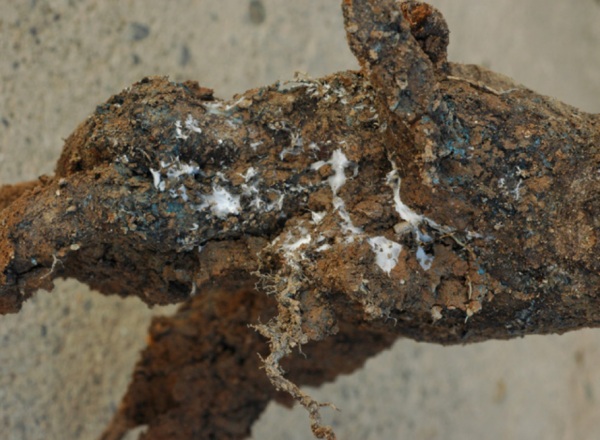
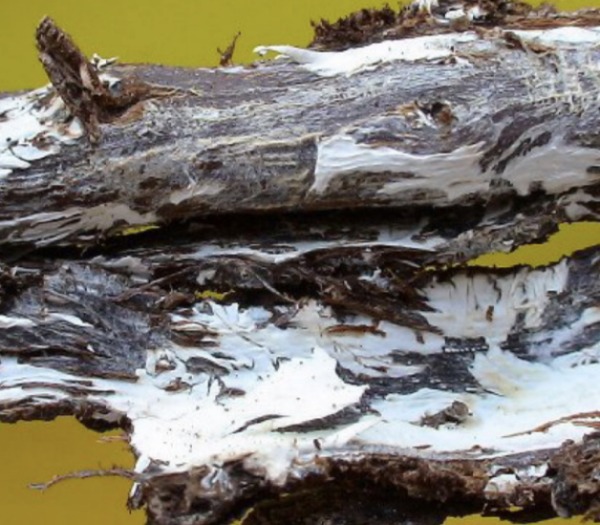
3.2. Control and prevention measures for Rosellinia and Armillaria
As in the previous cases, the control measures are focused on preventing the appearance of the disease, since there is no 100% effective method once it appears.
- Incorporate drainage systems that prevent waterlogging
- Avoid or minimize tillage in the vicinity of the tree to avoid the appearance of wounds in the roots, since they could be a potential entry for pathogens
- If in our orchard we have more fruit trees that may be susceptible to the disease or in the case of fruit plantations at an industrial level, we can choose to make ditches around the infected trees so that the disease does not spread to the adjacent ones.. Although, this measure would only work if we have detected the disease in advance.
- Make contributions of organic matter but it must be well composted and not contain undecomposed plant remains.
4. Powdery mildew (Sphaeroteca spp. and Podosphaera spp.)
Powdery mildew is a disease caused by fungi of the genus Sphaeroteca spp. and Podosphera spp., which affects pome and stone fruit trees, such as apple, peach and nectarine. It can also affect the vine, although in this case the disease would be caused by the fungus Erysiphe (Uncinula) necator.
These fungi overwinter in the shoots infected the previous year and it is during the following spring that they develop and reproduce, infecting the new shoots through the air. As in most diseases caused by fungi, its development will also be favored by high relative humidity, therefore, in irrigated orchards or plantations, its incidence may be higher.
4.1. Damage and symptoms caused by powdery mildew
It is a relatively simple disease to identify because the symptoms are quite characteristic: whitish spots with a cottony appearance will appear on the leaves, branches and fruits. If we try to remove them, we will observe that the underlying tissue shows necrosis or chlorosis.
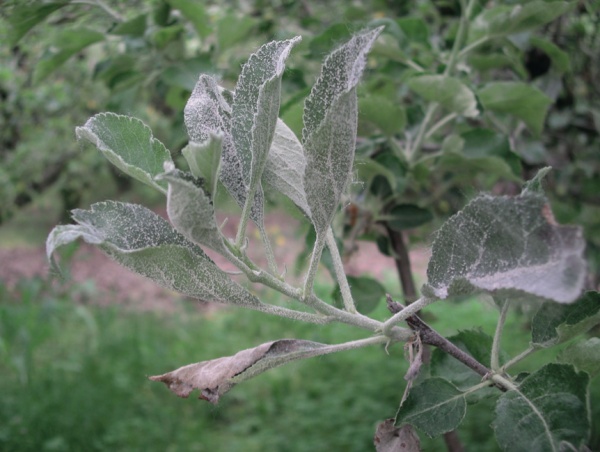
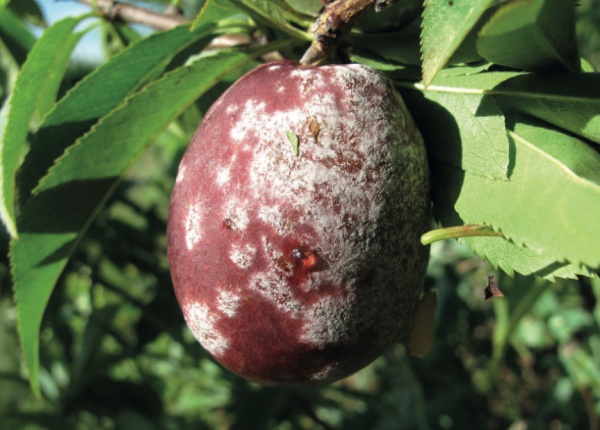
4.2. Control measures and prevention of powdery mildew
In the article Powdery mildew in the Garden: powdery mildew in cucumber, in pumpkin,… How to combat it? , you can find several strategies for both control and prevention of this disease. You will also find how to make preparations to combat it.
5. Bacterial canker (Pseudomonas)
Pseudomonas are a genus of bacteria capable of producing the disease called bacterial canker, which affects numerous species of fruit trees. The bacterium enters the tree through wounds caused during pruning, frost or by the mere fall of the leaves before winter. The following spring, rainwater serves as a carrier for this pathogen, carrying it to uninfected areas of the tree.
5.1. Damage and symptoms caused by Pseudomonas
As its name indicates, Pseudomonas will produce cankers on the trunk and branches, which are black or reddish wounds similar to those in the following image.
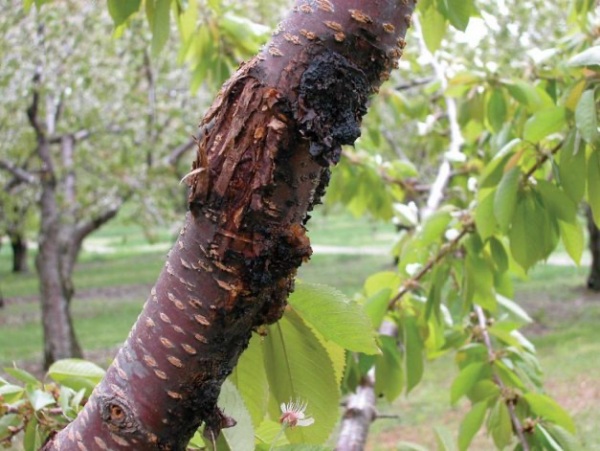
In addition, black spots or dots will appear on the leaves, flowers and fruits, which will cause deformation and necrosis in the tissues.
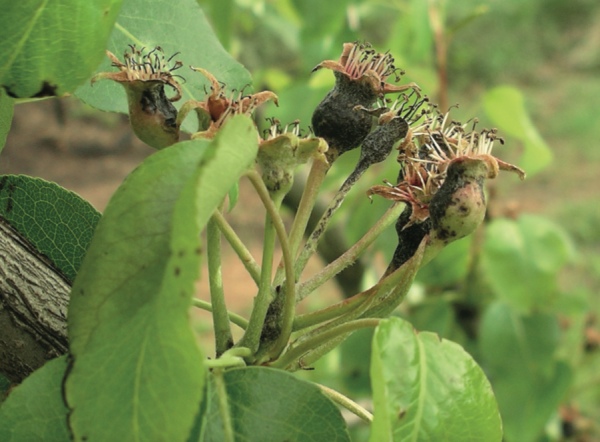
5.2. Pseudomonas control and prevention measures
The control of these bacteria is complicated because they multiply at high speed. Therefore, we will focus mainly on prevention strategies:
- Preventive treatments based on copper before winter can help reduce the probability of incidence of the disease.
- Avoid pruning in autumn, properly disinfecting the tools used
- Use varieties adapted to the climate of the area where our orchard or plantation is located. In this way we will avoid frost damage that can lead to the formation of wounds.
- Avoid fertilizing with excess nitrogen
- If the disease has already been established, cut the affected parts and, subsequently, apply healing agents.
6. Grapevine downy mildew (Plasmopara viticola)
Mildew is a disease caused by different fungi that can affect a wide range of crops. In the case of fruit trees, the incidence of downy mildew in vines, produced by the fungus Plasmopara viticola, stands out.
6.1. Damage and symptoms caused by mildew on the vine
This pathogen can appear in all the organs of the plant, producing different symptoms: in the stems it generates necrosis, in the leaves it produces oily yellowish spots on the upper side and a white fuzz on the underside.
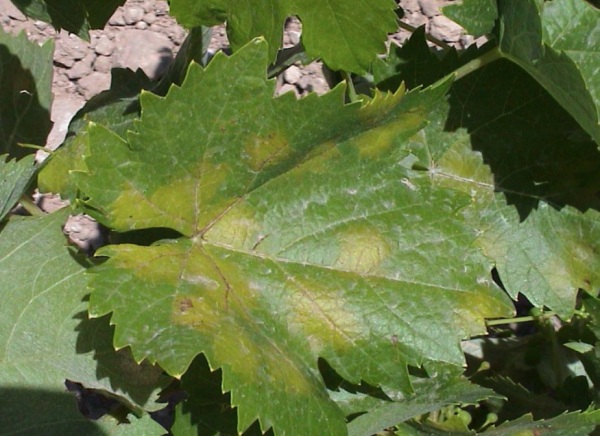
Symptoms can also appear on the bunches, such as the presence of white powder on the rachis or the wrinkling of the grapes.
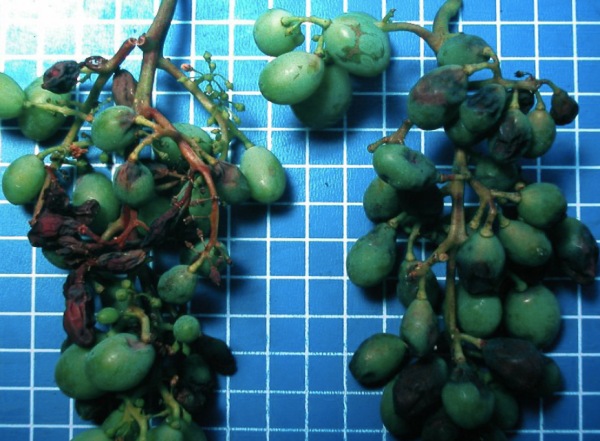
6.2. Mildew control and prevention measures
By way of prevention, it is important to maintain good aeration of the plant, especially in the cluster area. To do this, we can opt for green and/or leafless pruning. Preventive chemical treatments can also be applied at the beginning of flowering.
As control methods, I advise you to take a look at our articles 6 Ecological fungicides against fungi in the garden: Very effective or Homemade Fungicides: 10 Remedies against plant fungi, where we explain how to make homemade fungicides that work very well against this type of fungus.
7. Verticillium wilt (Verticillium)
Verticillium wilt is a disease also caused by a fungus, called Verticillium dahliae, which can appear in numerous crops. Among fruit trees, it is common in stone fruit trees, olive trees, almond trees, pistachio trees or avocado trees.
It is a fungus that is present in some soils, especially in those that are deep and humid, so the irrigation system will have a great influence when it comes to controlling the disease. In addition, Verticillium is capable of surviving in a soil for more than 15 years even if it does not have a host to live on.
7.1. Damage and symptoms caused by Verticillium
This pathogen enters the tree almost exclusively through the roots, although in some cases it could also access through the aerial part, for example, through a wound in the branches. Broadly speaking, we will observe a slowdown in the development of the tree and a decrease in size.
The leaves of the infected branches will present a yellowing from the tip to the part closest to its union with the branch and, over time, they will dry out. If we make a cut in one of the main branches, we will observe a dark stain in the internal tissue, similar to the one in the following image:
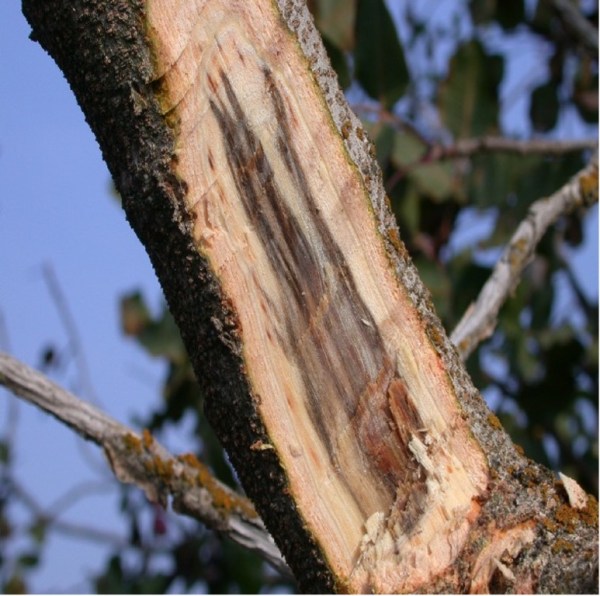
7.2. Verticillium control and prevention measures
As with other diseases that we have already mentioned, there is no 100% effective treatment that ends with Verticillium, so all practices are to prevent or mitigate the disease:
- Remove all infected parts of the tree, including already fallen leaves.
- remove weeds
- Reduce the irrigation dose
- Carry out applications of organic matter and techniques that reduce erosion
- balanced fertilization
- soil solarization
8. Apple and pear speckled (Venturia spp)
Mottle is the most important fungal disease in pome fruit trees. It is produced by the fungi Venturia pyrina in the case of the pear tree and Venturia inaequalis in the case of the apple tree. Its incidence is favored by the spring rains, which can, in many cases, lead to the total loss of the harvest.
During the winter, this fungus lives in a kind of bag located inside the fallen leaves on the ground, where it matures. Once it has matured, if these bags are wet by rainwater, they burst, projecting the spores onto the tree. If the fruit tree remains wet for more than 12 hours with a temperature range between 15 and 20ºC, the deposited spores will germinate causing the infection.
8.1. Damage and symptoms caused by Venturia
Venturia will cause damage to leaves and fruits, manifesting itself in the form of brown spots. The leaves can dry out and, in the case of the fruits, cracks can occur.
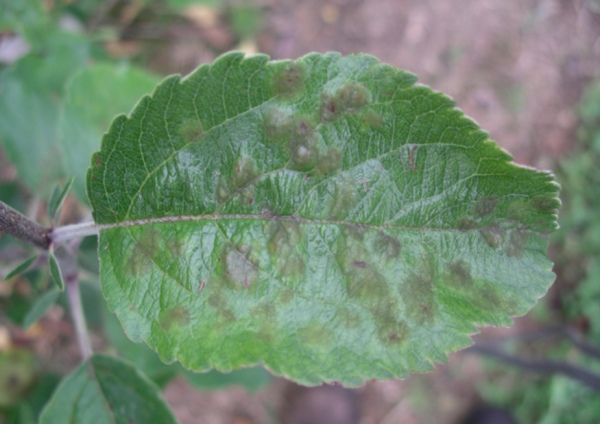
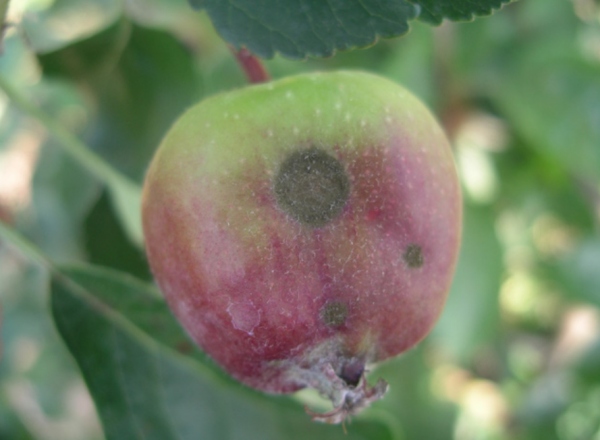
8.2. Venturia control and prevention measures
- Opt for more resistant varieties
- Carry out pruning that favors the aeration of the tree, so that it can dry faster after the rains
- In case we want to implement irrigation, we should avoid sprinkler irrigation and opt for drip irrigation.
- Remove fallen leaves from the ground to make it difficult for the fungus to survive during the winter
In case we want to use fungicides, they must be contact if their use is preventive, that is, when the disease has not yet appeared. On the contrary, if we have already observed symptoms, the fungicides must be penetrating or systemic.
9. Brown rot of stone fruit trees (Monilinia spp.)
Brown rot is a disease that can affect all stone fruit trees, such as peach, nectarine, cherry, almond or plum. It is produced by 3 species of fungi: Monilinia laxa, Monilinia fructigena and Monilinia fructicola, the former being the most widespread in Spain. Although, in other parts of the world, Monilinia fructicola is considered the most harmful.
9.1. Damage and symptoms caused by Monilinia
The first symptoms will be observed in the flowers, which will begin to wither at the beginning of spring.
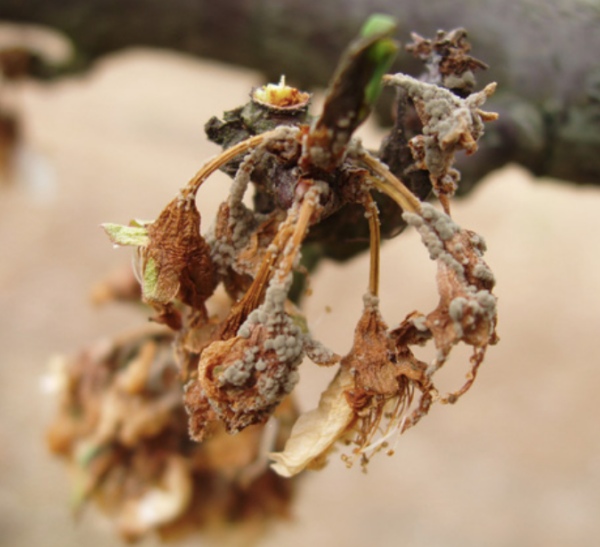
At the beginning of summer, symptoms will also appear on the fruits in the form of grayish spots that will rot quickly.
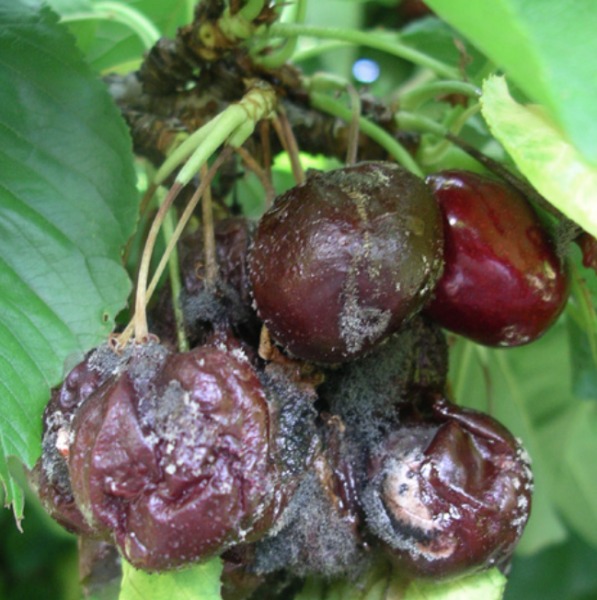
The fruits will not fall to the ground, but will remain on the tree, covered by a whitish cottony substance until they are completely mummified.
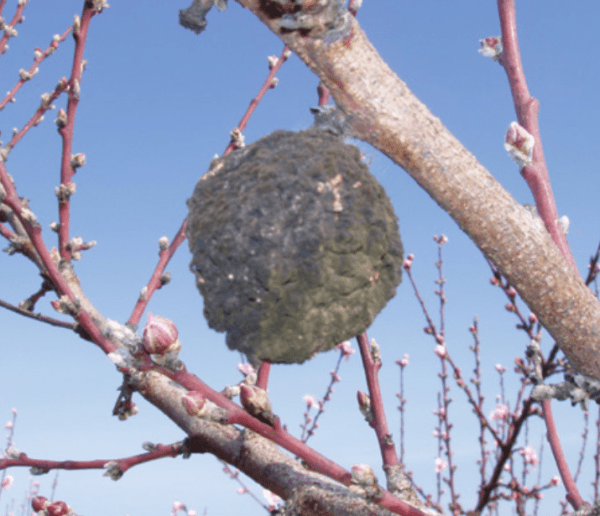
9.2. Control and prevention measures of Monilinia
- Remove all infected parts of the tree
- Perform practices that encourage aeration, such as pruning
- Reduce nitrogen fertilization
- Restrict irrigation, always opting for drip systems
In case of applying fungicides, it is worth mentioning that the treatments authorized in Spain are by way of prevention.
Bibliography
- Cruz A, Magdalena (2000) The crown gall in fruit trees. Chillan: Informative INIA Quilamapu. No. 38. Available at: https://biblioteca.inia.cl/handle/123456789/4305
- Ministry of Agriculture, Fisheries and Food. (2014) Integrated Pest Management of Citrus. Madrid: MAPA Publications Center.https://www.mapa.gob.es/es/agricultura/temas/sanidad-vegetal/GUIACITRICOS_tcm30-57942.pdf
- Ministry of Agriculture, Fisheries and Food. (2014) Integrated Pest Management of Table Grapes. Madrid: MAPA Publications Center.https://www.mapa.gob.es/es/agricultura/temas/sanidad-vegetal/GUIAUVADEMESA%20(2)_tcm30-57936.pdf
- Ministry of Agriculture, Fisheries and Food. (2014).Integrated Pest Management of Pome Fruit Trees. Madrid: MAPA Publications Center.https://www.mapa.gob.es/es/agricultura/temas/sanidad-vegetal/GUIA%20FRUTALES%20DE%20PEPITA_tcm30-57947.pdf
- Ministry of Agriculture, Fisheries and Food. (2015).Integrated Management of Almond Pests. Madrid: MAPA Publications Center. https://www.mapa.gob.es/es/agricultura/temas/sanidad-vegetal/guiadealmendroweb_tcm30-57951.pdf
- Ministry of Agriculture, Fisheries and Food. (2015).Integrated Pest Management of Stone Fruit Trees. Madrid: MAPA Publications Center https://www.mapa.gob.es/es/agricultura/temas/sanidad-vegetal/guiafrutalesdehuesoweb_tcm30-57949.pdf
- Ministry of Agriculture, Fisheries and Food. (2018).Pistachio Integrated Pest Management. Madrid: MAPA Publications Center https://www.mapa.gob.es/es/agricultura/temas/sanidad-vegetal/guiagippistachoweb_tcm30-444529.pdf
- Ministry of the Environment and Rural and Marine Affairs, Spanish Society of Phytopathology.Plant pathogens described in Spain, 2nd ed.https://www.mapa.gob.es/es/agricultura/publicaciones/patogenos%20final_tcm30-57872.pdf

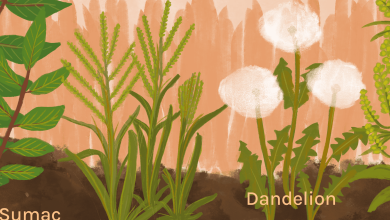
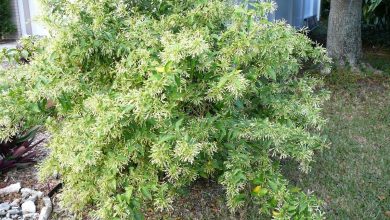
![Photo of [7] Varieties of Potatoes and their Characteristics](https://www.complete-gardening.com/wp-content/uploads/2022/08/7-varieties-of-potatoes-and-their-characteristics-390x220.jpg)
![Photo of Prune a Jacaranda: [Importance, Time, Tools, Considerations and Steps]](https://www.complete-gardening.com/wp-content/uploads/2021/06/Jacaranda_1621373875-390x220.jpg)